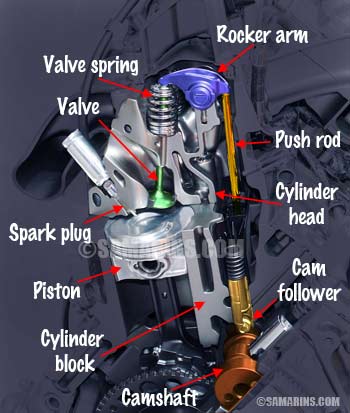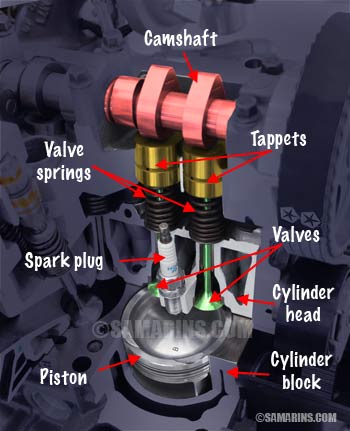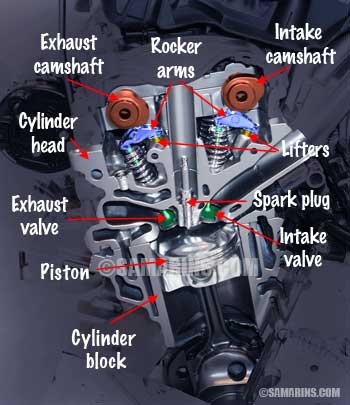What is the difference between OHV, OHC, SOHC and DOHC engines?
Updated: October 25, 2019
The main difference is in the placement of the camshaft. OHV means Over Head Valve. Although almost all modern car engines have valves placed in the cylinder head, the term OHV is used to describe a pushrod engine, with the camshaft placed in the cylinder block. OHC stands for Over Head Cam, or the camshaft is installed in the cylinder head. SOHC means Single Overhead Cam, while DOHC means Double Overhead Cam.Which one is better? It's always a heated argument. Muscle car fans will swear by an old-school pushrod, while younger car enthusiasts will say that nothing beats the twin-cam (DOHC). Each design has its pluses and minuses. Let's start with the good old Pushrod:
OHV or Pushrod engine
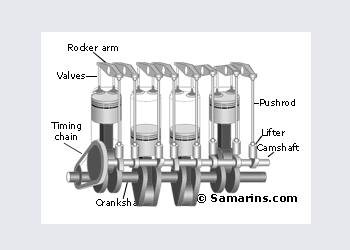 OHV or Pushrod engine animation
OHV or Pushrod engine animationThe downside of an OHV design is that it requires many moving components to operate the valves. Each component adds weight. This results in higher valvetrain inertia, making it difficult to control the valve timing at higher RPMs. This means that a small OHV engine will not be very efficient. The OHV design is more suitable for larger V6 and V8 engines; you won't find an OHV engine in a modern compact car.
Advantages of an OHV engine include a lower cost, higher low-end torque and more compact size. For example, the 2018 Chevrolet Corvette Z06 is 4.4 inches shorter than 2018 Honda Civic sedan. Yet, thanks to its compact 6.2L OHV V8, the Corvette Z06 can go from 0 to 60 mph in 2.9 seconds. The Corvette's supercharged aluminum 650-hp OHV LT4 engine pumps out a crazy 650 pound-feet of torque at 3,600 rpm.
See examples of OHV engines:
1. Chrysler Hemi 5.7L OHV V8 engine
2. GM 6.2L LSA V8.
OHC or SOHC engine
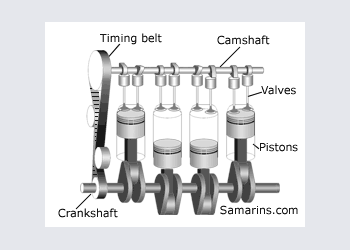 SOHC engine animation
SOHC engine animationIn a SOHC engine the camshaft is installed in the cylinder head, and valves are operated either by the rocker arms or directly through the lifters (as in this animation). See this photo of a Mitsubishi SOHC engine.
The advantage of the OHC design is that valves are operated almost directly by the camshaft, which makes it easier to maintain precise timing at higher rpms. It's also possible to install three or four valves per cylinder. Honda successfully uses the SOHC design in its late V6 engines where four valves per cylinder are operated by a single camshaft.
The downside of an OHC engine is that it requires a timing belt or chain with a tensioner and other related components. A timing belt must also be replaced at regular intervals. The timing chain lasts longer, but it too might need to be replaced if stretched. Another downside is that it's more difficult to implement variable valve timing separately for exhaust and intake valves; something that can be easily done in a DOHC engine.
DOHC or Twin-Cam engine
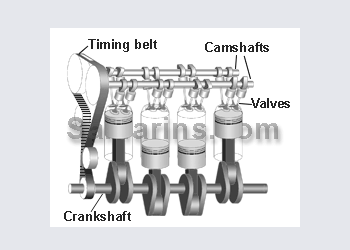 DOHC engine animation
DOHC engine animation A typical DOHC engine has two camshafts and four valves per cylinder, like the one in this animation. One camshaft operates intake valves, while another camshaft controls exhaust valves on the opposite side.
In a DOHC engine, camshafts can be installed farther apart from each other. This allows the intake valves to be at a larger angle from the exhaust valves, which results in a more direct air flow through the engine. In other words, a DOHC engine can "breathe" better, which means it can produce more horsepower out of a smaller engine volume. Compare: The 5.0-Liter V8 DOHC Coyote engine with 4 valves per cylinder of the 2018 Ford Mustang GT is rated at 460 hp @ 7,000 rpm. The 6.2-Liter OHV (pushrod) V8 GM L86 engine has two valves per cylinder and produces 420 horsepower at 5,600 rpm.
Examples of DOHC engines:
1. Ford 3.5L EcoBoost V6 DOHC
2. Ford Mustang Boss 302 5.0L DOHC V8
3. Ford Mustang 5.2L V8 Supercharged
4. BMW S65 DOHC V8
5. Infiniti 3.0L VR30
6. Mercedes-Benz Inline-6 DOHC engine.
7. Ford 2.3L EcoBoost turbocharged DOHC engine.
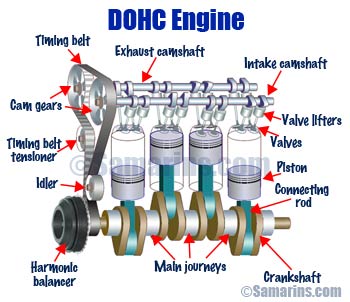 DOHC engine, click to see a larger image.
DOHC engine, click to see a larger image.Downsides of a DOHC engine include a larger size and more complex design with a timing belt or chain and related components. A timing belt needs to be replaced at recommended intervals, adding to maintenance costs. Replacing a timing chain is only necessary if it's stretched, or there is another related problem, but it could be expensive.
Conclusion: Currently, the DOHC engine design is the most fuel-efficient, but an old-school OHV engine will last longer in similar conditions and is cheaper to maintain.
Read Next:
Pros and cons of turbo engines.
Starting system, starter motor: problems, How the starting system is tested
Timing belt: when should it be replaced, what happens if it breaks
Serpentine belt, tensioner: problems, signs of wear, when to replace, noises
Check Engine light: what to check, common problems, repair options
Pros and cons of turbo engines.
Starting system, starter motor: problems, How the starting system is tested
Timing belt: when should it be replaced, what happens if it breaks
Serpentine belt, tensioner: problems, signs of wear, when to replace, noises
Check Engine light: what to check, common problems, repair options
